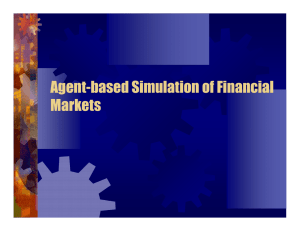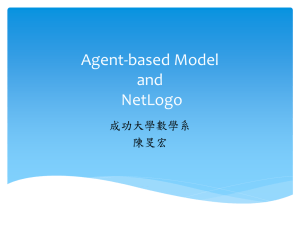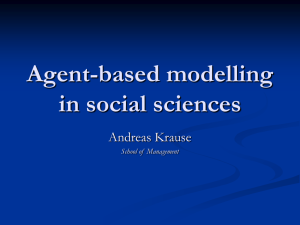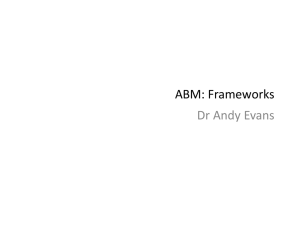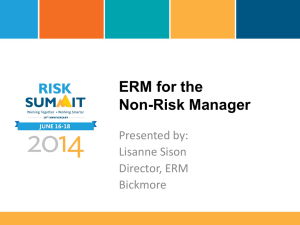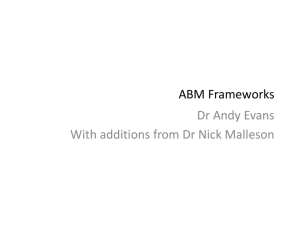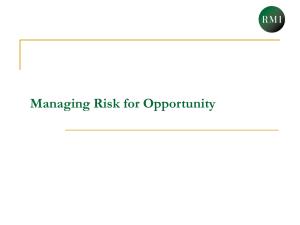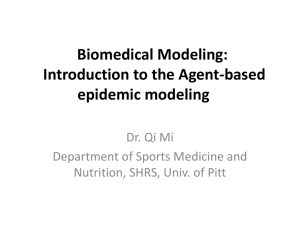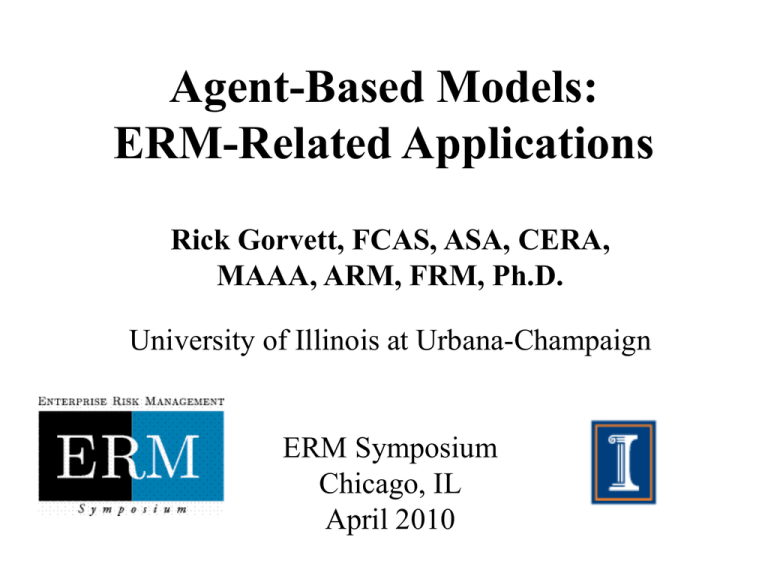
Agent-Based Models:
ERM-Related Applications
Rick Gorvett, FCAS, ASA, CERA,
MAAA, ARM, FRM, Ph.D.
University of Illinois at Urbana-Champaign
ERM Symposium
Chicago, IL
April 2010
“Who am I? Why am I here?”
- Admiral Stockdale, 1992
• Currently
– Director, Actuarial Science Program
– State Farm Companies Foundation Scholar in Actuarial
Science
– University of Illinois at Urbana-Champaign
– Various actuarial / DFA / ERM publications
– Mentor and direct undergraduate research
• Prior
– Corporate and consulting actuary
– Senior Vice President and director of internal audit &
risk management
U/G Research Associate Projects
•
•
•
•
•
Neuroeconomics / cognitive biases
Power laws
Predator-prey models
Fuzzy modeling of risk
Housing wealth: reverse mortgages and equity
releases
• Public pensions: securitizing pension claims
• Agent-based models
Agent-Based Models:
ERM-Related Applications
Agenda
• Framework: complexity and complex systems
– Description
– Validity?
• Cellular automata
• Agent-based modeling
– Principles and characteristics
– Examples
• Potential ERM-related applications
Complexity and Complex Systems
• A commonly heard definition: “the edge of
chaos”
– Between order and randomness
• Simple rules can lead to complex systems
• Self-organization
• Emergent phenomena
• Interrelationships
Complex Adaptive System (CAS)
• Interacting components / agents
• Emergent behavior / properties
– Self-organization (and reorganization)
– Macro (complex) properties are different from
micro (simple) properties
– Nonlinearity can’t simply project from micro to
macro
– Bottom-up rather than top-down
• Adaptive / evolving capability of agents
– Learning
– Feedback
– Often, move toward goal or objective
Examples of CASs
• Economy
• Financial markets / stock market
• Ecologies / ecosystem
• Brain / consciousness
• Social systems
• Organizations
Historical Recognition
“He intends only his own gain, and he is in
this, as in many other cases, led by an
invisible hand to promote an end which was
no part of his intention.”
- An Inquiry into the Nature and Causes of
the Wealth of Nations, Adam Smith, 1776
Complex Social Systems
“One must study the laws of human action
and social cooperation as the physicist
studies the laws of nature.”
- Human Action, Ludwig von Mises, 1949
Even in Classic Fiction…
War and Peace, by Leo Tolstoy
Book Eleven, Chapter 1
“Only by taking infinitesimally small units for
observation (the differential of history, that is,
the individual tendencies of men) and attaining
to the art of integrating them (that is, finding
the sum of these infinitesimals) can we hope to
arrive at the laws of history.”
Tolstoy continued…
War and Peace, by Leo Tolstoy
Second Epilogue, Chapter 9
“All cases without exception in which our conception of
freedom and necessity is increased and diminished
depend on three considerations:
(1) The relation to the external world of the man who
commits the deeds.
(2) His relation to time.
(3) His relation to the causes leading to the action.”
Tolstoy continued…
War and Peace, by Leo Tolstoy
Second Epilogue, Chapter 11
“And if history has for its object the study of the
movement of the nations and of humanity
and not the narration of episodes in the lives
of individuals, it too, …, should seek the
laws common to all the inseparably
interconnected infinitesimal elements of free
will.”
Is “Complexity Science of Any Use?
• “Why and how did this vague notion become
such a central motif in modern science? Is it only
a fashion, a kind of sociological phenomenon, or
is it a sign of a changing paradigm of our
perception of the laws of nature and of the
approaches required to understand them?”
- Vicsek, “The bigger picture,” Nature, July 11, 2002, p. 131
Murray Gell-Mann
Sante Fe Institute
•
•
•
•
•
Founded in 1984
Private, non-profit
Multidisciplinary research and education
Primarily a “visiting” institution
Current research focus areas
–
–
–
–
–
–
Cognitive neuroscience
Computation in physical and biological systems
Economic and social interactions
Evolutionary dynamics
Network dynamics
Robustness
The ERM Perspective
• Concerned with a broad financial and
operating perspective
• Recognizes interdependencies among
corporate, financial, and environmental factors
• Strives to determine and implement an optimal
strategy to achieve the primary objective:
maximize the value of the firm
• Recognizes that little things can have big
consequences
– Trying to avoid a “failure of imagination”
Issues in Advancing ERM
We can move ERM forward by better
understanding and appreciating
•
•
•
Complex adaptive systems
Evolutionary processes
Behavioral issues
Evolutionary Process
• There are several important parallels between
economic systems and biological evolutionary
theory
–
–
–
–
–
Complex systems
Self-organized agents / individuals
Adaptation / natural selection
Emergence of “order”
Understanding the historical process helps to
explain behavior
Biology and Economics
“The precise mathematical relationship which
describes the link between the frequency and
size of the extinction of companies, for
example, is virtually identical to that which
describes the extinction of biological species in
the fossil record. Only the timescales differ.”
- Why Most Things Fail: Evolution, Extinction &
Economics, Paul Ormerod, 2005
Behavioral Concerns
• Various well-documented “fallacies” can cause
inaccurate or biased estimates of values,
probabilities, etc. E.g.,
– Anchoring fallacy: bias toward an initial value
– Inattentional blindness: concentrating in one area
can induce blindness to other events
– Availability fallacy: immediately-available
examples have a perhaps undue influence on our
estimates
Cellular Automata
• Matrix of cells
• Each cell
– Follows a simple set of rules
– Interacts with one another
• Result: potentially unpredictable, complex
behavior
Game of Life
• Example of cellular automata
• Created by Mathematician John Conway (cited
in 1970 in Scientific American)
• Rules of behavior:
– Each cell either is or is not populated (i.e., living
or dead)
– Each cell with either 2 or 3 living neighbors
survives (into the next time-step)
– Each cell with 0 or 1 neighbors dies (loneliness)
– Each cell with 4+ neighbors dies (overpopulation)
Steps in the
Risk Management Process
•
•
•
•
•
•
•
Determine the corporation’s objectives
Identify the risk exposures
Quantify the exposures
Assess the impact
Examine alternative risk management tools
Select appropriate risk management approach
Implement and monitor program
Agent-Based Modeling (ABM)
•
•
•
•
Simulation
Discrete events and incremental time periods
Object-oriented programming
Agents which (potentially) interact with each
other
• Bottom-up programming
• Detailed behavior system (macro) behavior
• Insights into evolution of system
Agents
• Decision-makers
• Autonomous bundles of attributes and
processes
– State of nature, which can change over time
– Rules of behavior and interactions
• Potentially heterogeneous
• Collective, rather than individual, control of
overall system
• Emergent behavior
• Adaptability – learn, modify behavior
Some Past Applications of ABMs
• Flocks of birds
• Traffic jams
• Financial contagion
• Movements of ancient societies
• Housing segregation and other urban issues
• Disease propagation
ABM Software
• Lots of available software – e.g.,
– NetLogo ( http://ccl.northwestern.edu/netlogo/ )
• Prior incarnation was StarLogo
– Swarm ( http://www.swarm.org )
– Repast ( http://repast.sourceforge.net/ )
– Ascape ( http://ascape.sourceforge.net/ )
• We’ll use NetLogo in this presentation
Examples of ABMs
• Schelling – housing segregation
– Agent stays put if percentage of neighbors of same
“color” is at least as great as its preference
– Agent moves if percentage of neighbors of same
“color” is less than its preference
• Moves to nearest space where preference is satisfied
Copyright 1997 Uri Wilensky. All rights reserved. See
http://ccl.northwestern.edu/netlogo/models/Segregation for terms of use.
Examples of ABMs (cont.)
• Virus propagation – factors:
– Population density
– Infectiousness
– Duration of infectiousness
– Recovery potential and immunity
Copyright 1998 Uri Wilensky. All rights reserved. See
http://ccl.northwestern.edu/netlogo/models/Virus for terms of use.
Examples of ABMs (cont.)
• Marketing behavior and the Competitive
Insurance Market
• Factors:
– Initial market shares of firms
– Potential influence of other consumers in personal
“network”
– Marketing plans and capabilities
Potential Value of CAS and ABM
for ERM
• Detailed, rather than aggregate-level, modeling
– E.g., “it’s never happened before, so it can’t, or
won’t, in the future” fallacy
• Specific applications
– Finance and financial risk
– Strategy and strategic risk
• E.g., modeling competitive markets
– Operational risk
• E.g., organizational processes, cascading effects of
errors / fraud
ABM and Risk Analysis
“… sometimes risk is a property of a system as a
whole, an ‘emergent’ property. Then a
comprehensive, system-wide assessment of the
causal factors that lead to risk throughout the
system needs to be addressed. In this case, agentbased modeling is a natural approach to
representing the diverse characteristics and
decision-making behaviors of companies or
individuals that comprise the system or indistry.”
- Managing Business Complexity, North and Macal,
Oxford University Press, 2007
Conclusion
“The revolutionary idea that defines the
boundary between modern times and the past
is the mastery of risk”
- Peter Bernstein, Against the Gods

